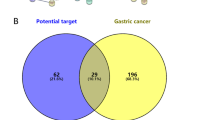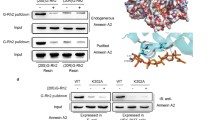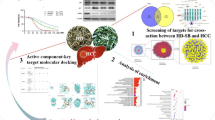Abstract
Glabridin, an isoflavone isolated from licorice, owns a variety of pharmacological effects. Several reports have demonstrated that glabridin could regulate multiple cellular signaling pathways to inhibit the progression of cancer. However, the target proteins have not been elucidated yet. We used shape screening and induced fit docking to screen the protein data bank against glabridin. Braf and MEK1/2, important intermediate molecules of the braf/MEK cascade, were identified as the potential targets of glabridin. The experimental data showed that glabridin could inhibit the phosphorylation of MEK1/2 and the phosphorylation levels of downstream molecules including ERK1/2 and transcription factors ATF1 and CREB, but had no effect on the phosphorylation of braf. In particular, the in vitro pull-down assay indicated that glabridin selectively bound to braf and MEK1/2. What is more, exposure to glabridin significantly suppressed the proliferation of hepatocellular carcinoma HepG2 cell line. In addition, glabridin might arrest cell cycle in G1 through downregulation of cyclinD3, CDK2, and CDK4. In conclusion, glabridin is a potential multi-molecule-targeting inhibitor in the field of clinical prevention or treatment of cancer.








Similar content being viewed by others
References
Belinky PA, Aviram M, Fuhrman B, Rosenblat M, Vaya J. The antioxidative effects of the isoflavan glabridin on endogenous constituents of LDL during its oxidation. Atherosclerosis. 1998;137:49–61.
Fuhrman B, Buch S, Vaya J, Belinky PA, Coleman R, Hayek T, et al. Licorice extract and its major polyphenol glabridin protect low-density lipoprotein against lipid peroxidation: In vitro and ex vivo studies in humans and in atherosclerotic apolipoprotein e-deficient mice. Am J Clin Nutr. 1997;66:267–75.
Kent UM, Aviram M, Rosenblat M, Hollenberg PF. The licorice root derived isoflavan glabridin inhibits the activities of human cytochrome p450s 3a4, 2b6, and 2c9. Drug Metab Dispos Biol Fate Chem. 2002;30:709–15.
Yehuda I, Madar Z, Leikin-Frenkel A, Tamir S. Glabridin, an isoflavan from licorice root, down-regulates inos expression and activity under high glucose stress and inflammation. Mole Nutr Food Res. 2015.
Huang HL, Hsieh MJ, Chien MH, Chen HY, Yang SF, Hsiao PC. Glabridin mediate caspases activation and induces apoptosis through JNK1/2 and p38 MAPK pathway in human promyelocytic leukemia cells. PLoS One. 2014;9:e98943.
Hsieh MJ, Lin CW, Yang SF, Chen MK, Chiou HL. Glabridin inhibits migration and invasion by transcriptional inhibition of matrix metalloproteinase 9 through modulation of NF-kappaB and ap-1 activity in human liver cancer cells. Br J Pharmacol. 2014;171:3037–50.
Tsai YM, Yang CJ, Hsu YL, Wu LY, Tsai YC, Hung JY, et al. Glabridin inhibits migration, invasion, and angiogenesis of human non-small cell lung cancer A549 cells by inhibiting the FAK/rho signaling pathway. Integr Cancer Ther. 2011;10:341–9.
Roberts PJ, Der CJ. Targeting the Raf-MEK-ERK mitogen-activated protein kinase cascade for the treatment of cancer. Oncogene. 2007;26:3291–310.
Sebolt-Leopold JS, Herrera R. Targeting the mitogen-activated protein kinase cascade to treat cancer. Nat Rev Cancer. 2004;4:937–47.
Wong KK. Recent developments in anti-cancer agents targeting the Ras/Raf/MEK/ERK pathway. Recent Pat Anticancer Drug Discov. 2009;4:28–35.
Dobbelstein M, Moll U. Targeting tumour-supportive cellular machineries in anticancer drug development. Nat Rev Drug Discov. 2014;13:179–96.
Flaherty KT, Infante JR, Daud A, Gonzalez R, Kefford RF, Sosman J, et al. Combined BRAF and MEK inhibition in melanoma with BRAF v600 mutations. N Engl J Med. 2012;367:1694–703.
Villanueva J, Vultur A, Lee JT, Somasundaram R, Fukunaga-Kalabis M, Cipolla AK, et al. Acquired resistance to BRAF inhibitors mediated by a RAF kinase switch in melanoma can be overcome by cotargeting MEK and IGF-1R/PI3K. Cancer Cell. 2010;18:683–95.
Confgen version 2.9, Schrödinger, LLC, New York, NY, 2014.
Maestro version 9.9, Schrödinger, LLC, New York, NY, 2014.
Berman HM, Westbrook J, Feng Z, Gilliland G, Bhat TN, Weissig H, et al. The protein data bank. Nucleic Acids Res. 2000;28:235–42.
Phase version 4.0, Schrödinger, LLC, New York, NY, 2014.
Schrödinger suite 2014 Induced Fit Docking protocol; Glide version 6.4, Schrödinger, LLC, New York, NY, 2014; Prime version 3.7, Schrödinger, LLC, New York, NY, 2014.
Schrödinger suite 2014 Protein Preparation Wizard; Epik version 2.9, Schrödinger, LLC, New York, NY, 2014; Impact version 5.7, Schrödinger, LLC, New York, NY, 2014; Prime version 3.7, Schrödinger, LLC, New York, NY, 2014.
Friesner RA, Banks JL, Murphy RB, Halgren TA, Klicic JJ, Mainz DT, et al. Glide: a new approach for rapid, accurate docking and scoring. 1. Method and assessment of docking accuracy. J Med Chem. 2004;47:1739–49.
Dixon SL, Smondyrev AM, Knoll EH, Rao SN, Shaw DE, Friesner RA. PHASE: a new engine for pharmacophore perception, 3D QSAR model development, and 3D database screening: 1. Methodology and preliminary results. J Comput Aided Mol Des. 2006;20:647–71.
Glide version 6.4, Schrödinger, LLC, New York, NY, 2014.
Aoki F, Nakagawa K, Kitano M, Ikematsu H, Nakamura K, Yokota S, et al. Clinical safety of licorice flavonoid oil (LFO) and pharmacokinetics of glabridin in healthy humans. J Am Coll Nutr. 2007;26:209–18.
Lapenna S, Giordano A. Cell cycle kinases as therapeutic targets for cancer. Nat Rev Drug Discov. 2009;8:547–66.
Chen Q, Lin J, Jinno S, Okayama H. Overexpression of Cdk6-cyclin D3 highly sensitizes cells to physical and chemical transformation. Oncogene. 2003;22:992–1001.
Meloche S, Pouyssegur J. The ERK1/2 mitogen-activated protein kinase pathway as a master regulator of the G1- to S-phase transition. Oncogene. 2007;26:3227–39.
Chambard JC, Lefloch R, Pouyssegur J, Lenormand P. ERK implication in cell cycle regulation. Biochim Biophys Acta. 2007;1773:1299–310.
Lee CJ, Lee HS, Ryu HW, Lee MH, Lee JY, Li Y, et al. Targeting of magnolin on ERKs inhibits Ras/ERKs/RSK2-signaling-mediated neoplastic cell transformation. Carcinogenesis. 2014;35:432–41.
Globocan 2012, IARC.
Lee KK, Kim DG, Moon IS, Lee MD, Park JH. Liver transplantation versus liver resection for the treatment of hepatocellular carcinoma. J Surg Oncol. 2010;101:47–53.
Evan GI, Vousden KH. Proliferation, cell cycle and apoptosis in cancer. Nature. 2001;411:342–8.
McKillop IH, Schmidt CM, Cahill PA, Sitzmann JV. Altered expression of mitogen-activated protein kinases in a rat model of experimental hepatocellular carcinoma. Hepatology (Baltimore, Md). 1997;26:1484–91.
Ito Y, Sasaki Y, Horimoto M, Wada S, Tanaka Y, Kasahara A, et al. Activation of mitogen-activated protein kinases/extracellular signal-regulated kinases in human hepatocellular carcinoma. Hepatology (Baltimore, Md). 1998;27:951–8.
Chen L, Shi Y, Jiang CY, Wei LX, Wang YL, Dai GH. Expression and prognostic role of pan-Ras, Raf-1, pMEK1 and pERK1/2 in patients with hepatocellular carcinoma. Eur J Surg Oncol J Eur Soc Surg Oncol British Asso Surg Oncol. 2011;37:513–20.
Hsiao WL, Liu L. The role of traditional Chinese herbal medicines in cancer therapy—from TCM theory to mechanistic insights. Planta Med. 2010;76:1118–31.
Xia Z, Dickens M, Raingeaud J, Davis RJ, Greenberg ME. Opposing effects of ERK and JNK-p38 MAP kinases on apoptosis. Science. 1995;270:1326–31.
Deschesnes RG, Huot J, Valerie K, Landry J. Involvement of p38 in apoptosis-associated membrane blebbing and nuclear condensation. Mol Biol Cell. 2001;12:1569–82.
Acknowledgments
This work was supported by the National Natural Science Foundation of China (31170676, 81372137), the Scientific Research Foundation for the Returned Overseas Chinese Scholars, the State Education Ministry (2014-1685), and the Scientific Research Foundation for Returned Overseas Scholars of Guangdong Medical University, China (B2012082). This work was also supported by the funds from the 2013 Sail Plan “the Introduction of the Shortage of Top-Notch Talent” Project (YueRenCaiBan [2014] 1), Science and Technology Planning Project (2013B021800072), and Education Discipline Construction Project (2013KJCX0090) of Guangdong Province, China. Finally, we thank Dr Feng Zhu from Huazhong University of Scientific and Technology for putting forward useful suggestions in the experiment as well as Schrödinger for providing an evaluation license.
Author information
Authors and Affiliations
Corresponding authors
Ethics declarations
Conflicts of interest
None
Rights and permissions
About this article
Cite this article
Wang, Z., Luo, S., Wan, Z. et al. Glabridin arrests cell cycle and inhibits proliferation of hepatocellular carcinoma by suppressing braf/MEK signaling pathway. Tumor Biol. 37, 5837–5846 (2016). https://doi.org/10.1007/s13277-015-4177-5
Received:
Accepted:
Published:
Issue Date:
DOI: https://doi.org/10.1007/s13277-015-4177-5




